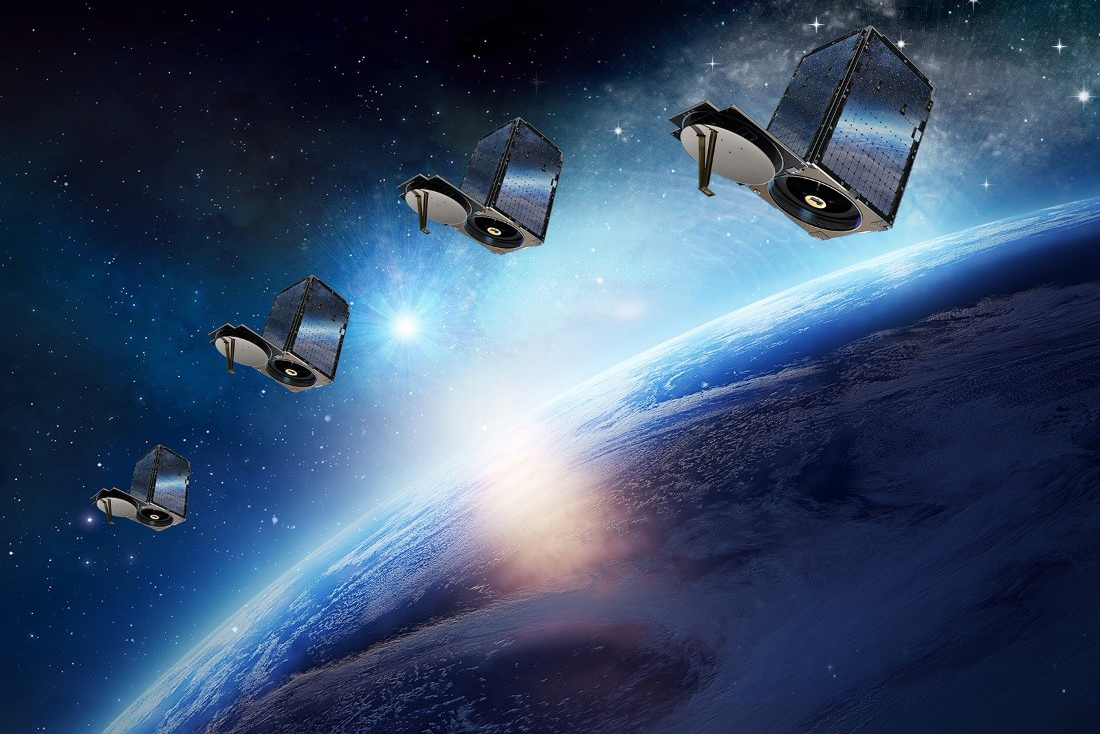.
8.08.2016
Peru’s first Earth observation satellite arrives in French Guiana for its Vega launch

After touching down in French Guiana aboard a cargo jetliner, the protective shipping container with PerúSAT-1 is positioned via crane for its transportation by road to the Spaceport.
The PerúSAT-1 passenger for Arianespace’s next Vega mission is now in French Guiana, where payload preparations are beginning for a September liftoff from the Spaceport.
Built by Airbus Defence and Space based on its AstroBus-S platform, the spacecraft was transported from Toulouse, France – where it was produced – aboard a cargo aircraft, which touched down in French Guiana at Cayenne’s Félix Eboué Airport late last week.
Following its transfer by road to the Spaceport’s S3B payload preparation facility, PerúSAT-1 is in position for final checkout and integration with Vega before lifting off from the South American launch facility – where Arianespace operates its family of light-lift Vega, medium-weight Soyuz and heavy-lift Ariane 5 vehicles.
PerúSAT-1 – which is the first Earth observation satellite for Peru – was ordered by the country’s government for its national space agency, CONIDA (La Comisión Nacional de Investigación y Desarrollo Aeroespacial). The spacecraft incorporates an advanced silicon carbide instrument system designed to deliver imagery at a 70-cm. resolution over a lifetime of 10 years.
Designated VV07 in Arianespace’s numbering system, next month’s Vega mission will mark the light-lift vehicle’s seventh flight from French Guiana since beginning operations from this equatorial launch site in 2012. It also will be the first Vega mission to be performed by Arianespace in 2016.
Quelle: arianespace
-
Update: 31.08.2016
-
Vega’s September launch to Sun-synchronous orbit

Peru’s PerúSAT-1 Earth observation satellite is fueled in the Spaceport’s S3B facility in preparation for a September orbiting by Arianespace’s Vega launcher.
Elsewhere at the Spaceport, preparations are continuing for Arianespace’s September 15 launch of a lightweight Vega vehicle – as this mission’s PerúSAT-1 Earth observation satellite has now been fueled in the S3B payload preparation facility.
PerúSAT-1 is equipped with a silicon carbide optical instrument system to image Earth at 70 cm. resolution, and will serve as Peru’s first Earth observation satellite. With a liftoff mass of approximately 450 kg., PerúSAT-1 will operate from Sun-synchronous orbit.
The Vega mission with PerúSAT-1 is designated Flight VV07 in Arianespace’s launcher family numbering system, signifying the light-lift vehicle’s seventh launch overall, and its first in 2016 from Europe’s Spaceport in French Guiana.
---
Vega’s multi-satellite payload integration begins for Arianespace Flight VV07

This photo series shows PerúSAT-1 being placed in the VESPA dispenser system for multi-satellite payloads carried by Vega (at left), followed by its encapsulation (center and right).
PerúSAT-1 has been installed in the multi-payload dispenser system that will enable this spacecraft to be launched on Arianespace’s upcoming Vega light-lift mission from French Guiana, along with a cluster of satellites for Terra Bella.
The integration activity occurred in the Spaceport’s S3B preparation facility, where PerúSAT-1 was installed inside the VESPA dispenser – readying it for positioning as the lower payload on Vega Flight VV07, scheduled for liftoff on September 15.
VESPA is similar in function to the larger SYLDA dispenser on Ariane 5’s heavy-lift launch vehicle. These systems enable multiple payloads to be assembled on a single launcher and orbited in sequence during a mission.
PerúSAT-1’s deployment in Vega’s flight sequence
For Flight VV07, the Terra Bella satellites will be released in the second phase of the mission’s deployment sequence.
PerúSAT-1 was built by Airbus Defence and Space for Peru’s CONIDA national space agency and is outfitted with a silicon carbide optical instrument system to image Earth at 70 cm. resolution. It will serve as the country’s first Earth observation satellite, with a liftoff mass of approximately 450 kg.
Quelle: arianespace
-
Update: 10.09.2016
.
Vega’s payload is “buttoned up” for launch by Arianespace
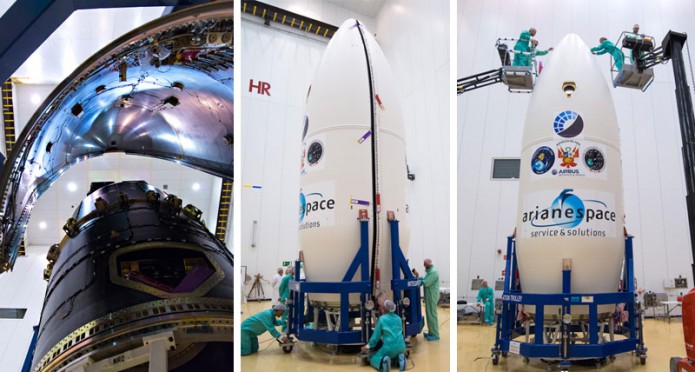
Encapsulation of Flight VV07’s passengers is highlighted in these three photos. At left, one of the payload fairing’s half-shells is positioned around the payloads, seen in an image looking upward from the VESPA dispenser system that contains PerúSAT-1. In the photos at center and right, the two-piece payload fairing is closed up to complete the encapsulation process.
The passengers for Arianespace’s upcoming Vega flight are now encapsulated in their protective fairing. This component will shield the mission’s PerúSAT-1 and Terra Bella satellites during initial climb-out from French Guiana on September 15.
Encapsulation, performed in the Spaceport’s S3B preparation facility, marked completion of the payload integration phase for Arianespace Flight VV07, which will place the Peruvian Earth observation and Terra Bella spacecraft into elliptic low-Earth orbits.
The satellite passengers’ arrangement places PerúSAT-1 – a very high resolution optical observation spacecraft developed for Peru’s CONIDA national space agency – in a dispenser system called VESPA (Vega Secondary Payload Adaptor). Terra Bella’s spacecraft are in the upper position atop VESPA.
The seventh mission for Arianespace’s light-lift Vega
With the satellites now encapsulated in the payload fairing, this upper component of Vega – referred to as the “composite” – is ready for installation atop the launcher early next week.
During the September 15 mission, separation of the payload fairing will occur approximately four minutes into the flight, once Vega has ascended through the atmosphere’s denser layers.
Flight VV07 is scheduled for a nighttime liftoff from the Spaceport on the seventh launch overall for this lightweight vehicle. Vega is part of Arianespace’s launcher family that also includes the medium-lift Soyuz and heavyweight Ariane 5. The four-stage Vega is delivered to Arianespace by Italy’s ELV, which is production prime contractor.
Another busy year of launches for Arianespace
To date, Arianespace has conducted six of 11 missions targeted for 2016, with Flight VV07 to mark the first liftoff with its Vega launcher this year.
The company’s launches accomplished so far in 2016 were:
- Flight VA232, conducted on August 24 with an Ariane 5 to orbit the Intelsat 33e and Intelsat 36 telecommunications satellites for U.S.-based Intelsat;
- Flight VA230, on June 18, using an Ariane 5 to loft EchoStar XVIII for the U.S. EchoStar provider of satellite/video delivery solutions, and the BRIsat financial communications relay platform for Indonesia;
- Flight VS15, on May 24, orbiting two Full Operational Capability (FOC) satellites for Europe’s Galileo space-based navigation system with Soyuz;
- Flight VS14, lifting off on April 25, utilized Soyuz to deploy the European Sentinel-1B radar-equipped Earth observation platform, along with the French Microscope scientific payload and Europe’s Fly Your Satellite! educational cubesats;
- Flight VA229, performed with Ariane 5 on March 9 to orbit the EUTELSAT 65 West A telecommunications relay satellite for Europe’s Eutelsat satellite operator; and
- Flight VA228, on January 27, orbiting the Intelsat 29e telecom relay platform aboard an Ariane 5.
---
PerúSAT-1 and Terra Bella satellites are installed for Arianespace’s upcoming Vega launch

This series of images shows Flight VV07’s upper composite while being transported to the SLV launch pad (photo at left), followed by its hoisting up the mobile gantry and installation atop Vega (center and right).
Arianespace’s seventh light-lift Vega launcher to be operated from the Spaceport in French Guiana is now fully assembled, having been “topped off” with its multi-satellite Earth observation payload.
Designated Flight VV07 in Arianespace’s launcher family numbering system, the September 15 mission will involve a trajectory to elliptical low-Earth orbit, where Vega will deploy a cluster of satellites for U.S.-based Terra Bella and the Peruvian PerúSAT-1 spacecraft.
This is to mark Arianespace’s seventh launch of 2016, building on a busy schedule that already has seen the company’s heavy-lift Ariane 5 utilized four times, along with two missions performed by medium-lift Soyuz launchers.
Integration of Vega’s “upper composite” in the gantry
Flight VV07’s final payload integration activity began with the “upper composite’s” transfer from the Spaceport’s S3B payload processing facility to the SLV launch pad. The upper composite is composed of the Terra Bella satellites along with PerúSAT-1 in a dispenser system for the multi-passenger arrangement, all of which are encapsulated in Vega’s protective payload fairing.
Once positioned on the launch pad, the upper composite was then hoisted up Vega’s mobile gantry, where it was installed atop the four-stage launcher.
Vega entered service in 2012, and the vehicle is provided to Arianespace by Italy’s ELV S.P.A., which is the launcher industrial prime contractor.
Quelle: arianespace
-
Update: 14.09.2016
.

- LAUNCH VEHICLE
- Vega
- LAUNCH DATE
- September 15, 2016
- STATUS
- Upcoming
- PAYLOAD(S)
- PerúSAT-1, SkySats-4 to -7
- CUSTOMER(S)
- Airbus Defence and Space, CONIDA, Terra Bella
- PRIME CONTRACTOR(S)
- Airbus Defence and Space, SSL
- LAUNCH SITE
- Spaceport, French Guiana (Guiana Space Center)
- ORBIT
- Sun-Synchronous orbit
MISSION
DESCRIPTION
A multi-payload Vega mission for Earth observation
For its seventh launch of the year, and seventh Vega mission since the light launcher began operations at the Guiana Space Center French Guiana, in 2012, Arianespace will orbit the PerúSAT-1 satel-lite as part of a turnkey contract with Airbus Defence and Space for the Peruvian space agency CONIDA, and the SkySats-4 to 7 satellites for the American operator Terra Bella, a Google company.
With this multi-payload Vega mission, Arianespace clearly confirms that its light launcher offers the adaptability needed to meet emerging requirements in the broad-based Earth observation market.
PAYLOADS
- PerúSAT-1
-
PerúSAT-1 is Peru’s first Earth observation satellite. Ordered within the scope of an agreement between the Peruvian and French governments, this launch is being carried out under a turnkey contract with Airbus Defence and Space for the Peruvian space agency CONIDA.
PerúSAT-1 is a powerful optical observation satellite featuring very high resolution (0.7 meters). It is equipped with a latest-generation silicon carbide optical sensor.
Built by Airbus Defence and Space in Toulouse, France, using an AstroBus-S platform and its NAOMI instrument, the satellite will be injected into Sun-synchronous orbit at an altitude of 675 km. PerúSAT-1 will operate at an altitude of 695 km to take pictures of the entire globe.
PerúSAT-1 will be the 115th satellite built by Airbus Defence and Space to be launched by Arianespace. Arianespace’s order book includes 13 more satellites from this manufacturer, along with a special order for the OneWeb constellation, involving over 600 satellites.
- SkySats-4 To -7
-
SkySat-4, 5, 6 and -7 are the first four of these micro-satellites to be launched by Arianespace for Terra Bella, a new customer and a commercial operator of Earth observation satellites.
Terra Bella is a Google company using data from space to solve problems on Earth. SkySat-4, 5, 6, and 7 will augment Terra Bella’s existing 3 on-orbit satellites—growing the constellation and enabling Terra Bella to help enterprise customers solve the challenges affecting their business and generate insights into important global economic, environmental, and humanitarian challenges.
The four satellites, SkySats-4 to 7, will be injected into a Sun-synchronous orbit at an altitude of 500 km. They will be used to provide very-high-resolution (sub meters) maps of the entire Earth.
COUNTDOWN
AND FLIGHT
The countdown comprises all final preparation steps for the launcher, the satellites and the launch site, in-cluding the steps leading up to authorization of P80 first-stage ignition.
- Events
-
-
- - 09H
- Start of final countdown
-
- - 05H 50MN
- Activation of Multi-Functional Unit (MFU)
-
- - 05H 30MN
- Activation of Inertial Reference System (IRS)
-
- - 05H 30MN
- Activation of telemetry
- SHOW THE COUNTDOWN
-
- LIFTOFF
- 00:00
- SHOW THE COUNTDOWN
-
- + 00H 40MN 21S
- SkySat-4 release command
-
- + 00H 40MN 23S
- SkySat-5 release command
-
- + 00H 40MN 25S
- SkySat-6 release command
-
- + 00H 40MN 28S
- SkySat-7 release command
-
- + 00H 54MN 44S
- 3rd ignition of AVUM
-
- + 00H 55MN 31S
- 3rd cut-off of AVUM
-
- + 01H 41MN 20S
- 4rd ignition of AVUM
-
- + 01H 42MN 5S
- 4d cut-off of AVUM
-
- + 01H 42MN 59S
-
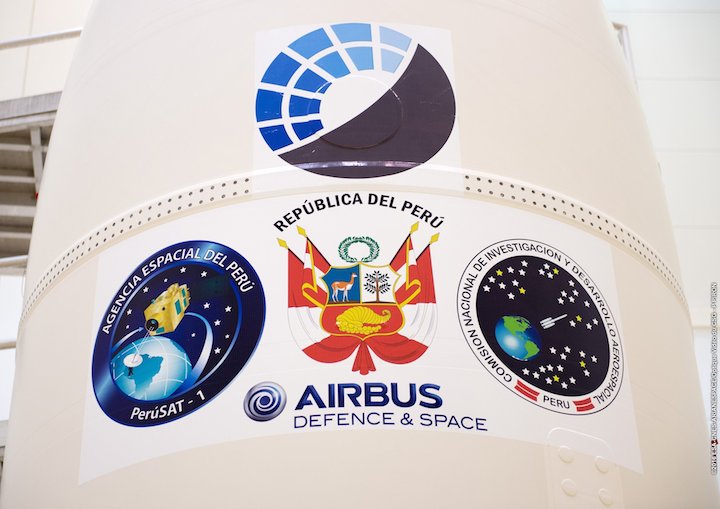

-
Update: 15.09.2016
.

Quelle: arianespace
...Update: 16.40 MESZ
|
|||
Quelle: arianespace
.
Update: 16.09.2016 / 7.40 MESZ
-
ARIANESPACE ORBITS FIVE EARTH OBSERVATION SATELLITES FOR PERU AND NEW OPERATOR TERRA BELLA, MARKING VEGA’S 7TH SUCCESSFUL LAUNCH IN A ROW
Arianespace has successfully launched the PerúSAT-1 satellite, within the scope of a contract with Airbus Defence and Space for the Peruvian space agency CONIDA, and the SkySat-4 to -7 satellites for American operator Terra Bella, a Google company.
The launch took place on September 15 at 10:43:35 pm local time from the Guiana Space Center in Kourou, French Guiana.
Designated Flight VV07, this was Arianespace’s seventh launch of the year and also the seventh consecutive successful launch by Vega, the latest member of the Arianespace launcher family, introduced at the Guiana Space Center in 2012. Vega is especially well suited to the dynamic Earth observation market. With this launch it starts full-fledged commercial operation, and already has nine future launches in its order book.
-
Frams von Vega-VV07 Start:

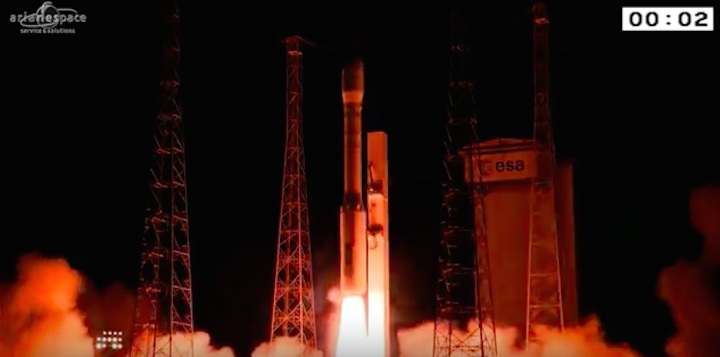
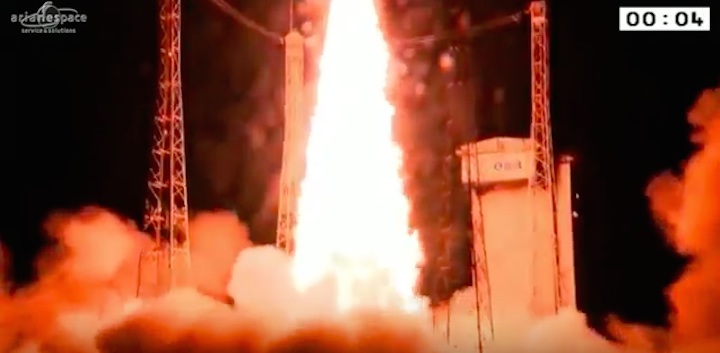

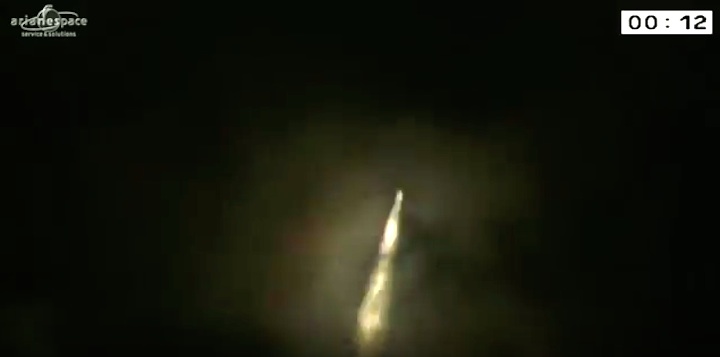




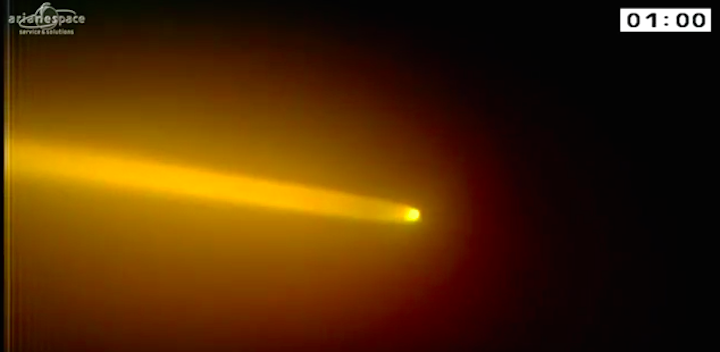



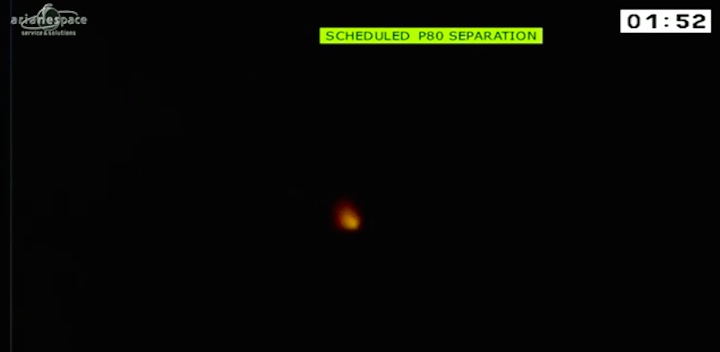

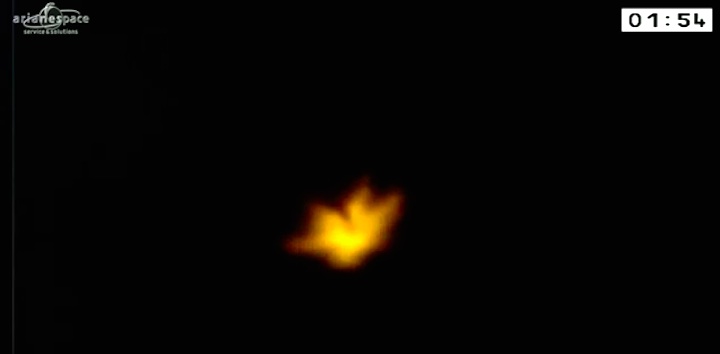

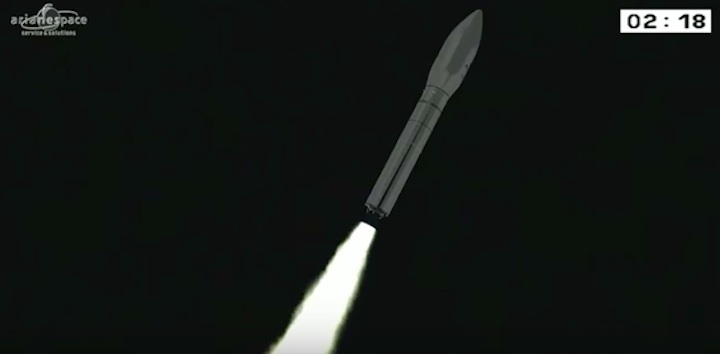
Quelle: arianespace


